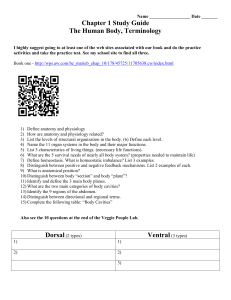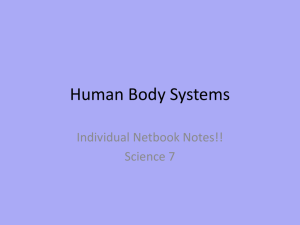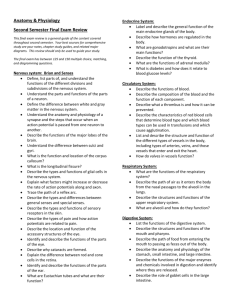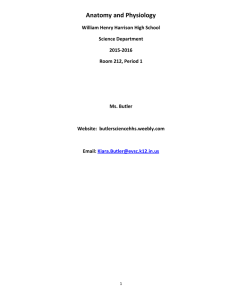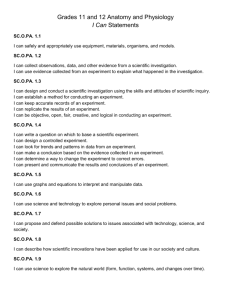Anatomy and Physiology 2013-2014 Ms. Ruidera
advertisement
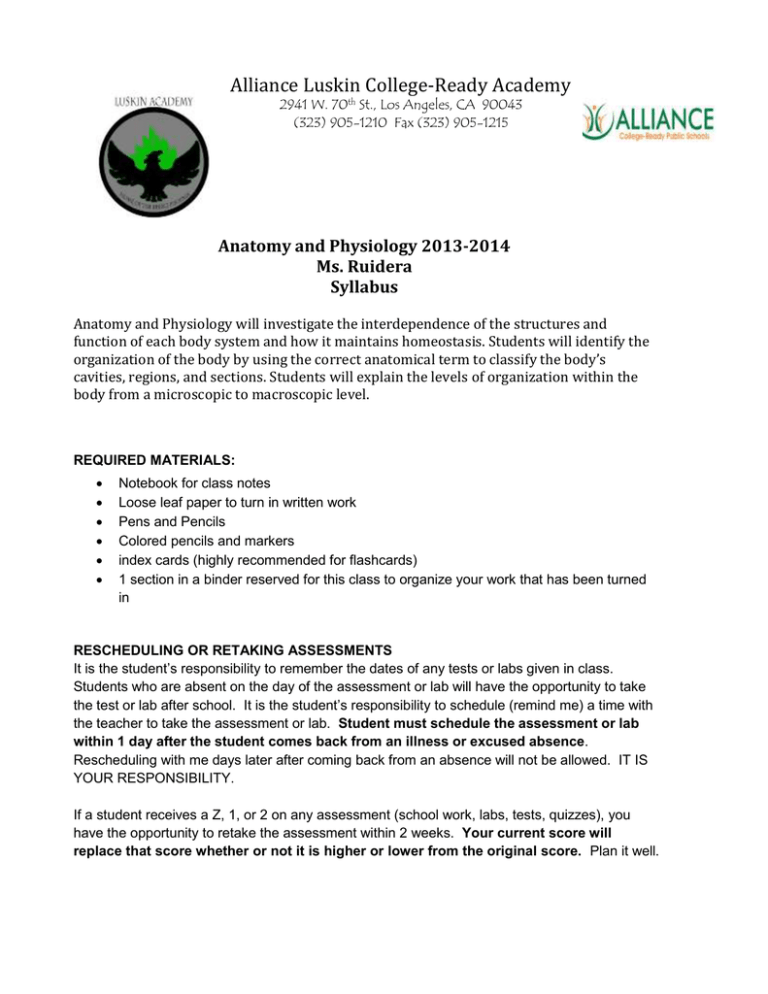
Alliance Luskin College-Ready Academy 2941 W. 70th St., Los Angeles, CA 90043 (323) 905-1210 Fax (323) 905-1215 Anatomy and Physiology 2013-2014 Ms. Ruidera Syllabus Anatomy and Physiology will investigate the interdependence of the structures and function of each body system and how it maintains homeostasis. Students will identify the organization of the body by using the correct anatomical term to classify the body’s cavities, regions, and sections. Students will explain the levels of organization within the body from a microscopic to macroscopic level. REQUIRED MATERIALS: Notebook for class notes Loose leaf paper to turn in written work Pens and Pencils Colored pencils and markers index cards (highly recommended for flashcards) 1 section in a binder reserved for this class to organize your work that has been turned in RESCHEDULING OR RETAKING ASSESSMENTS It is the student’s responsibility to remember the dates of any tests or labs given in class. Students who are absent on the day of the assessment or lab will have the opportunity to take the test or lab after school. It is the student’s responsibility to schedule (remind me) a time with the teacher to take the assessment or lab. Student must schedule the assessment or lab within 1 day after the student comes back from an illness or excused absence. Rescheduling with me days later after coming back from an absence will not be allowed. IT IS YOUR RESPONSIBILITY. If a student receives a Z, 1, or 2 on any assessment (school work, labs, tests, quizzes), you have the opportunity to retake the assessment within 2 weeks. Your current score will replace that score whether or not it is higher or lower from the original score. Plan it well. CHEATING Students will receive a 0 and a phone call home in the event of cheating. No retakes are allowed. ABSENCE BINDER When you come back from an absence, it is your responsibility to look in the absence binder for any missing work. After 2 weeks and you have not picked up your missing work, it will be taken out of the binder. Course Schedule – this is tentative and may change at my discretion August 2013 Introduction to the body systems: Distinguish between anatomy and physiology. Use correct terminology when identifying body sections, cavities, and regions. Describe the body’s function in maintaining homeostasis. Sequence the levels of organization from the cell to an organism September 2013 Epithelial Tissue and Integumentary System: Identify structures of the skin and describe its role in protecting the body. Explain the physiology of the skin and how skin cells multiply. Identify the structures of the hair and nails. Explain how the skin provides nonspecific defenses against infection Study diseases associated with the skin. October 2013 Skeletal System Distinguish between different types of bones and joints. Identify major bones of the body. Explain the function of the skeleton system. Describe the mechanisms involved in development, growth, and repair of bones. Study diseases associated with the skeletal system November - December 2013 Muscular System Describe the types of muscles. Illustrate the steps associated with muscle contraction. Understand the relationship between the skeletal system and muscular system. January – February 2014 Nervous System Compare and contrast the central and peripheral nervous system. Describe the structure and function of neurons. Illustrate action potential. Identify the parts of the brain. Identify structure and functions of sensory organs. Study diseases of the nervous system. Summarize the transmission of nerve impulses. Describe feedback loops in the nervous system. March 2014 Cardiovascular System Diagram and label the parts of the heart. Trace the flow of blood from the heart to an organ. Compare and contrast the three types of blood vessels. Distinguish between pulmonary and systemic circulation. Describe the composition of blood. Compare the four blood types. Define and describe the cardiac cycle. Study cardiovascular diseases. Respiratory System Identify the components of the respiratory system. Explain gas exchange. Study respiratory diseases and how smoking affects the respiratory system. April 2014 Digestive System Identify the structures of the digestive system and explain their function. Trace the pathway of food through the alimentary canal. List the organs that responsible for chemical and mechanical digestion. Create a chart listing the enzymes, where they are secreted, and their function. Explain cellular respiration. Study pathology of the digestive system such as acid reflux, diarrhea, colon cancer, and ulcers. Excretory System Identify structures of the excretory system and describe their functions. Describe blood filtration through the kidneys. Label a nephron. Distinguish between filtration and reabsorption in the nephrons. Immune System Identify the structures of the lymphatic system Describe the role of antibodies in the body’s response to infection. Explain how vaccines work. Distinguish between specific and nonspecific defenses. Know the differences between bacteria and viruses. Understand why an individual with a compromised immune system such as AIDS may not be able to fight off microorganisms. May-June 2014 Endocrine System Identify the location of and functions of the endocrine glands. List the hormones associated with each gland as well as their actions. Reproductive System Compare and contrast the male and female reproductive system. Explain the production of sperm and eggs. Identify the phases of the menstrual cycle. Study sexually transmitted diseases.
